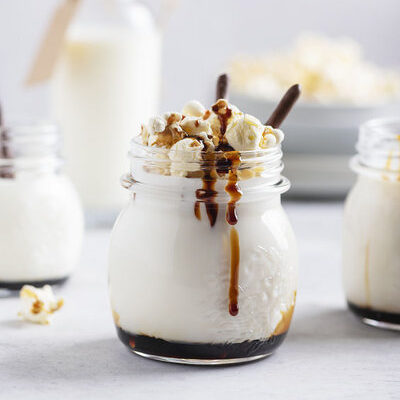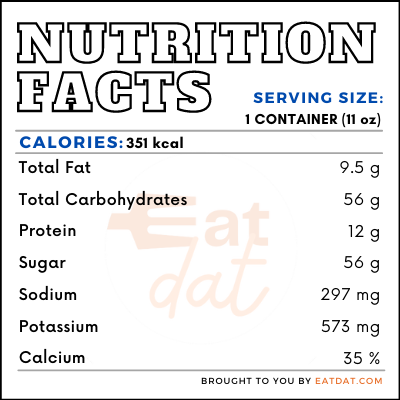
Vanilla Milkshake
What is Vanilla Milkshake?
A vanilla milkshake is a thick, cold drink made with milk, to which vanilla ice cream and vanilla extract are added. Toppings like dry fruits, chocolate sprinkles, candies, and whipped cream may also be added. Vanilla milkshake is one of the most popular milkshakes around the world, after only chocolate milkshake.
- There is a common misconception among consumers that vanilla milkshakes are purely made of milk, and hence, are healthier.
- In the US, the 20th of June is National Vanilla Milkshake Day.
The top 8 most popular milkshake maker brands are:
- Waring
- Cuisinart
- Hamilton Beach
- Nostalgia
- Breville
- Proctor Silex
- Oster Chocomilera
- MYONAZ
Origin of vanilla milkshake
In the 1800s, a milkshake was first considered eggnog made with whiskey. Later, the first mention of a milkshake appeared in 1885. Within 15 years, the whiskey was gone and the modern milkshake with all its different flavors was born. However, these milkshakes were still shaken by hand. Hamilton Beach would later invent the drink mixer in 1911, which would aid in the development of this beverage.
In 1922, Steven Poplawski invented the blender and Ivar Coulson added vanilla ice cream to the malted milk drink at Walgreens. Within a decade of these two developments, modern milkshakes with ice cream and syrup were in vogue. When refrigerators became common in most households in the 1930s, milkshakes also became easy to store. Today, milkshakes are a popular food around the world, with vanilla being one of the preferred flavors.
Nutrition
The nutritional value for one container of milkshake:

*Percentages are based on a diet of 2000 calories a day.
Milkshakes contain milk, which is a good source of protein and calcium, as well as a host of micronutrients, including phosphorus, magnesium, sodium, potassium, and sulfur. They also contain ice cream, a source of healthy fats, as well as copper, cobalt, iodine, manganese, zinc, fluorine, molybdenum, and selenium. However, research shows that without a blend of different food items, a mixture of fats and sucrose can lead to obesity.
Commercial production
Most restaurants use milkshake machines to prepare this beverage. To begin, milk, vanilla extract, and vanilla ice cream are added to a cup. Then, the cup is screwed into place and the ingredients are blended. The basic recipe has milk to ice cream ratio of 1:2. The resulting thick liquid is then poured into a glass and toppings are added, according to preference.
Vanilla milkshakes recipes
Vanilla milkshake is easily made with only a few ingredients: vanilla ice cream, milk, sugar, and vanilla extract. Here are a few popular recipes:
- Classic Vanilla Milkshake
- Chocolate Vanilla Milkshake
- Honey Vanilla Milkshake
- Dates Milkshake
- Mango Mastani
- Dry Fruits Milkshake
FDA regulations
The Food & Drug Administration stipulates that one milkshake serving should be 240 ml. The FDA also defines ice cream as food produced by stirring and freezing dairy ingredients. Ice cream must contain at least 1.6 pounds of solids to the gallon and must have at least 10 percent milk fat.
Vanilla extract is defined as the solution in aqueous ethyl alcohol of the sapid and odorous principles extractable from vanilla beans, in which the content of ethyl alcohol must not be less than 35 percent. In addition, milk also comes under the purview of the FDA, which defines it as the lacteal secretion of healthy cows. Milk must be free of colostrum and must be pasteurized.
References
“Packaged Milkshakes Market Size, Share: Global Industry Report, 2025.” Grandviewresearch.com, Grand View Research, 1 Aug. 2019, www.grandviewresearch.com/industry-analysis/packaged-milkshakes-market.
“Milkshake: Beverage.” Truefoodfact.com, True Food Fact, 18 Aug. 2020, truefoodfact.com/beverage/milkshake/.
Mason Howard, How to Use a Milkshake Machine, SF Gate, https://homeguides.sfgate.com/how-to-use-a-milkshake-machine-13409433.html
Naleid, Amy M et al. “Deconstructing the vanilla milkshake: the dominant effect of sucrose on self-administration of nutrient-flavor mixtures.” Appetite vol. 50,1 (2008): 128-38. doi:10.1016/j.appet.2007.06.011, https://www.ncbi.nlm.nih.gov/pmc/articles/PMC2266682/
